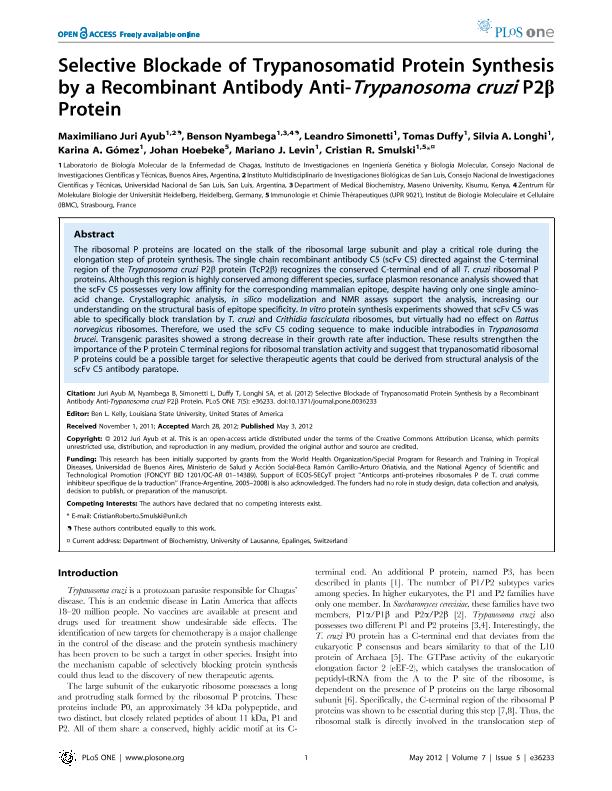Mostrar el registro sencillo del ítem
dc.contributor.author
Juri Ayub, Maximiliano

dc.contributor.author
Nyambega, Benson
dc.contributor.author
Simonetti, Leandro

dc.contributor.author
Duffy, Tomás

dc.contributor.author
Longhi, Silvia Andrea

dc.contributor.author
Gomez, Karina Andrea

dc.contributor.author
Hoebeke, Johan
dc.contributor.author
Levin, Mariano Jorge

dc.contributor.author
Smulski, Cristian Roberto

dc.date.available
2019-07-11T17:37:03Z
dc.date.issued
2012-05
dc.identifier.citation
Juri Ayub, Maximiliano; Nyambega, Benson; Simonetti, Leandro; Duffy, Tomás; Longhi, Silvia Andrea; et al.; Selective blockade of trypanosomatid protein synthesis by a recombinant antibody anti-trypanosoma cruzi P2β protein; Public Library of Science; Plos One; 7; 5; 5-2012; 1-9; e36233
dc.identifier.issn
1932-6203
dc.identifier.uri
http://hdl.handle.net/11336/79358
dc.description.abstract
The ribosomal P proteins are located on the stalk of the ribosomal large subunit and play a critical role during the elongation step of protein synthesis. The single chain recombinant antibody C5 (scFv C5) directed against the C-terminal region of the Trypanosoma cruzi P2β protein (TcP2β) recognizes the conserved C-terminal end of all T. cruzi ribosomal P proteins. Although this region is highly conserved among different species, surface plasmon resonance analysis showed that the scFv C5 possesses very low affinity for the corresponding mammalian epitope, despite having only one single amino-acid change. Crystallographic analysis, in silico modelization and NMR assays support the analysis, increasing our understanding on the structural basis of epitope specificity. In vitro protein synthesis experiments showed that scFv C5 was able to specifically block translation by T. cruzi and Crithidia fasciculata ribosomes, but virtually had no effect on Rattus norvegicus ribosomes. Therefore, we used the scFv C5 coding sequence to make inducible intrabodies in Trypanosoma brucei. Transgenic parasites showed a strong decrease in their growth rate after induction. These results strengthen the importance of the P protein C terminal regions for ribosomal translation activity and suggest that trypanosomatid ribosomal P proteins could be a possible target for selective therapeutic agents that could be derived from structural analysis of the scFv C5 antibody paratope.
dc.format
application/pdf
dc.language.iso
eng
dc.publisher
Public Library of Science

dc.rights
info:eu-repo/semantics/openAccess
dc.rights.uri
https://creativecommons.org/licenses/by-nc-sa/2.5/ar/
dc.subject
Trypanosoma Cruzi
dc.subject
Ribosomal P Proteins
dc.subject
Recombinant Antibody
dc.subject
Translation Inhibition
dc.subject.classification
Salud Ocupacional

dc.subject.classification
Ciencias de la Salud

dc.subject.classification
CIENCIAS MÉDICAS Y DE LA SALUD

dc.title
Selective blockade of trypanosomatid protein synthesis by a recombinant antibody anti-trypanosoma cruzi P2β protein
dc.type
info:eu-repo/semantics/article
dc.type
info:ar-repo/semantics/artículo
dc.type
info:eu-repo/semantics/publishedVersion
dc.date.updated
2019-07-10T13:40:11Z
dc.journal.volume
7
dc.journal.number
5
dc.journal.pagination
1-9; e36233
dc.journal.pais
Estados Unidos

dc.journal.ciudad
San Francisco
dc.description.fil
Fil: Juri Ayub, Maximiliano. Consejo Nacional de Investigaciones Científicas y Técnicas. Instituto de Investigaciones en Ingeniería Genética y Biología Molecular "Dr. Héctor N. Torres"; Argentina. Consejo Nacional de Investigaciones Científicas y Técnicas. Centro Científico Tecnológico Conicet - San Luis. Instituto Multidisciplinario de Investigaciones Biológicas de San Luis. Universidad Nacional de San Luis. Facultad de Ciencias Físico Matemáticas y Naturales. Instituto Multidisciplinario de Investigaciones Biológicas de San Luis; Argentina
dc.description.fil
Fil: Nyambega, Benson. Consejo Nacional de Investigaciones Científicas y Técnicas. Instituto de Investigaciones en Ingeniería Genética y Biología Molecular "Dr. Héctor N. Torres"; Argentina. Maseno University; Kenia. Universitat Heidelberg; Alemania
dc.description.fil
Fil: Simonetti, Leandro. Consejo Nacional de Investigaciones Científicas y Técnicas. Instituto de Investigaciones en Ingeniería Genética y Biología Molecular "Dr. Héctor N. Torres"; Argentina
dc.description.fil
Fil: Duffy, Tomás. Consejo Nacional de Investigaciones Científicas y Técnicas. Instituto de Investigaciones en Ingeniería Genética y Biología Molecular "Dr. Héctor N. Torres"; Argentina
dc.description.fil
Fil: Longhi, Silvia Andrea. Consejo Nacional de Investigaciones Científicas y Técnicas. Instituto de Investigaciones en Ingeniería Genética y Biología Molecular "Dr. Héctor N. Torres"; Argentina
dc.description.fil
Fil: Gomez, Karina Andrea. Consejo Nacional de Investigaciones Científicas y Técnicas. Instituto de Investigaciones en Ingeniería Genética y Biología Molecular "Dr. Héctor N. Torres"; Argentina
dc.description.fil
Fil: Hoebeke, Johan. Institut de Biologie Moleculaire et Cellulaire; Francia
dc.description.fil
Fil: Levin, Mariano Jorge. Consejo Nacional de Investigaciones Científicas y Técnicas. Instituto de Investigaciones en Ingeniería Genética y Biología Molecular "Dr. Héctor N. Torres"; Argentina
dc.description.fil
Fil: Smulski, Cristian Roberto. Consejo Nacional de Investigaciones Científicas y Técnicas. Instituto de Investigaciones en Ingeniería Genética y Biología Molecular "Dr. Héctor N. Torres"; Argentina
dc.journal.title
Plos One

dc.relation.alternativeid
info:eu-repo/semantics/altIdentifier/doi/http://dx.doi.org/10.1371/journal.pone.0036233
dc.relation.alternativeid
info:eu-repo/semantics/altIdentifier/url/https://journals.plos.org/plosone/article?id=10.1371/journal.pone.0036233
Archivos asociados
